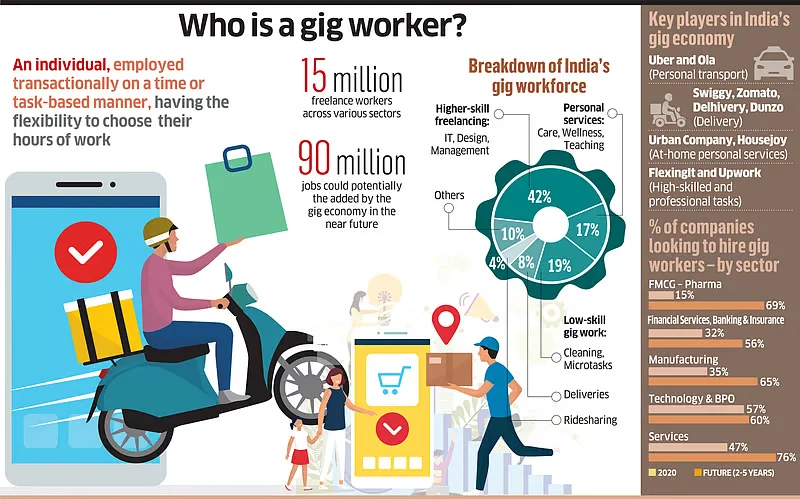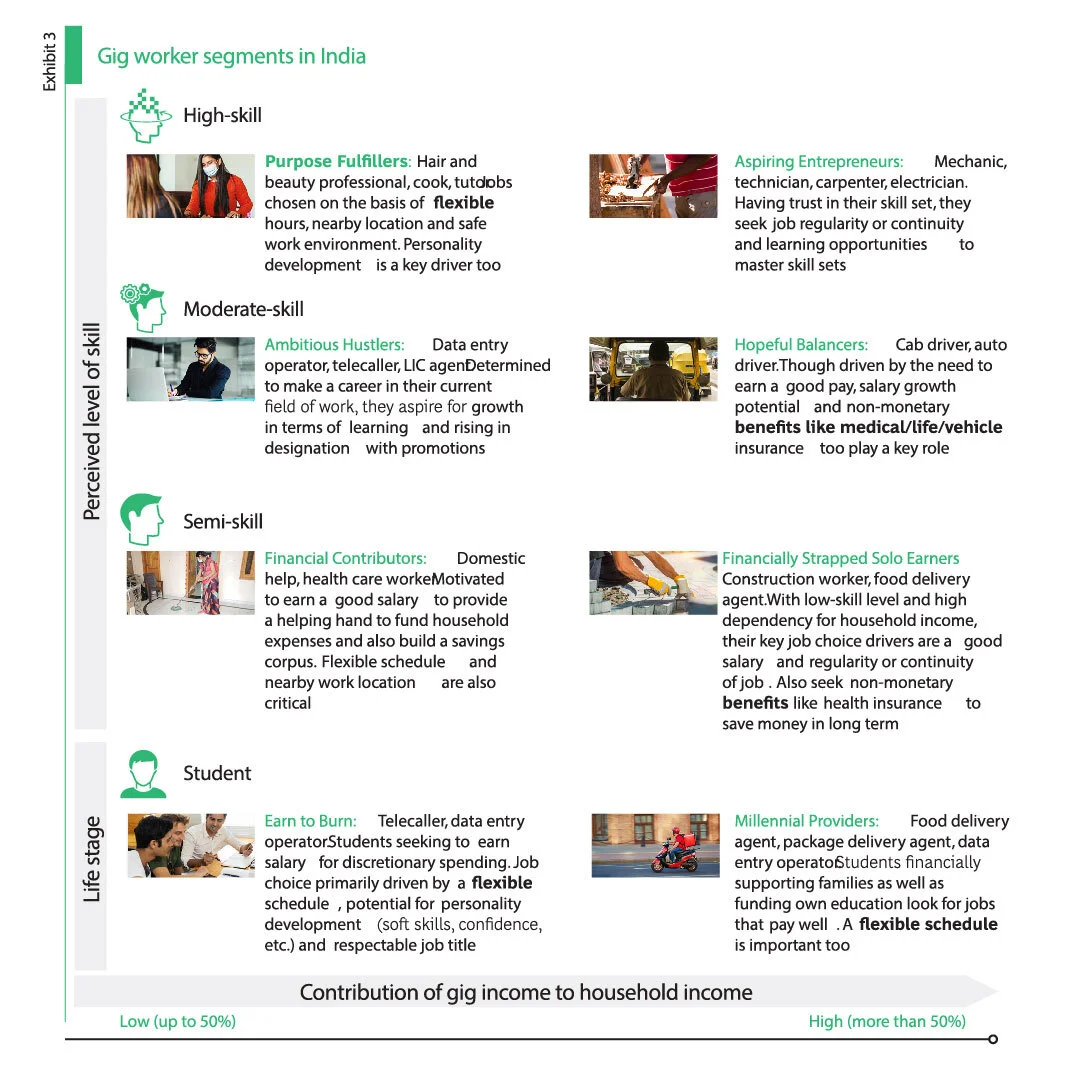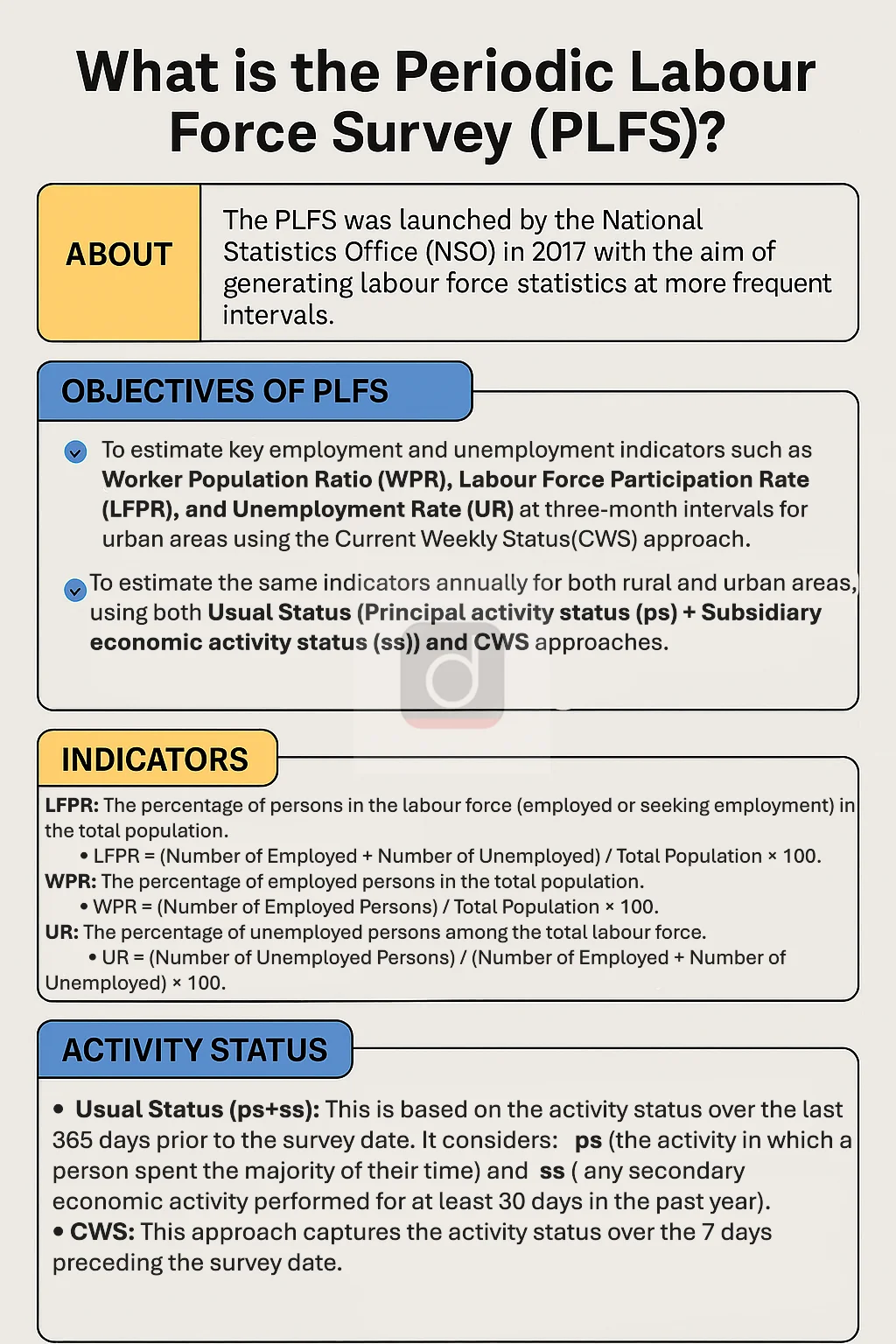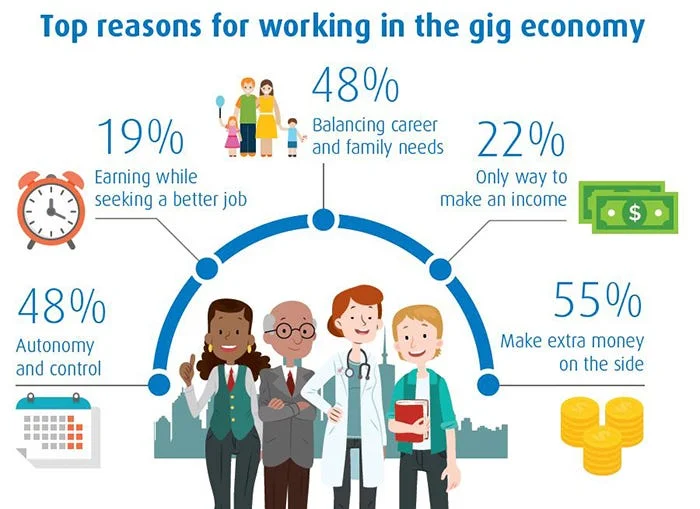Indian Economy
Bridging the Gaps: Strengthening India's Gig Economy
- 07 Jul 2025
- 12 min read
For Prelims: Periodic Labour Force Survey (PLFS), Gig Workers, NITI Aayog, E-commerce, Artificial Intelligence (AI), Minimum Wage, Code on Social Security, 2020, NITI Aayog Report on India's Gig and Platform Economy (2022),e-Shram Portal,
For Mains: Role of Gig Economy in India’s Economic Growth, Key Issues Associated with the Gig Economy in India.
Why in News?
The Union Budget 2025-26 formally recognised gig and platform workers, extending social protection schemes to them. However, the Periodic Labour Force Survey (PLFS) still lacks a dedicated classification, creating a gap between policy intent and data clarity, which hampers inclusive and effective policymaking.
What is the Gig Economy and What are the Current Gaps in Its Classification?
- About: The gig economy is a labour market based on short-term, flexible, and task-based work, often facilitated by digital platforms.
- As per section 2(35) of Code on Social Security, 2020, a gig worker is “a person who performs work or participates in a work arrangement and earns from such activities outside the traditional employer-employee relationship.”
- They are usually freelancers or independent contractors, paid per task instead of regular wages. Examples include food delivery, ride-hailing, and online freelance services.
- Key Segments:
- Status and Classification Gap: India had 7.7 million gig workers in 2020–21, projected to reach 23.5 million by 2029–30 (NITI Aayog), mostly in medium-skilled jobs.
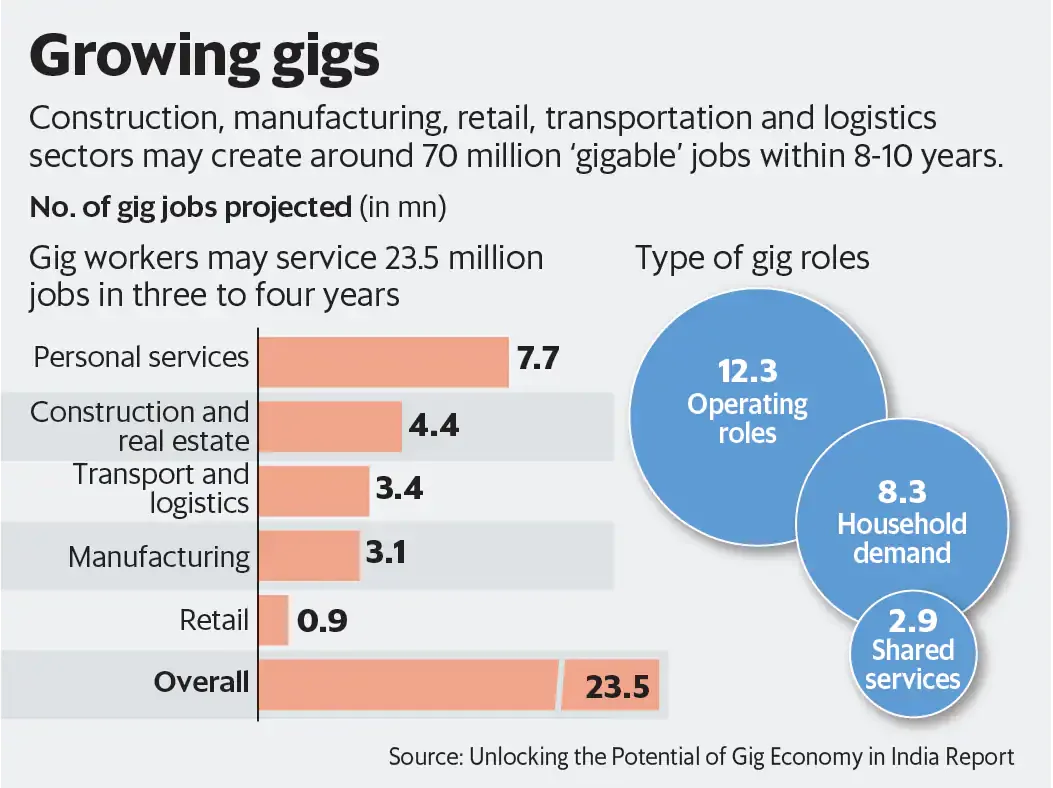
- However, the PLFS does not have a distinct classification for gig workers, grouping them under broad categories like self-employed or casual labour.
- Although gig and platform workers are technically included under "economic activity," their unique work conditions—characterized by algorithmic control, lack of formal contracts, irregular hours, and multi-platform engagement—are not adequately captured.
- This classification gap leads to:
- Exclusion from welfare schemes, as PLFS data guides beneficiary targeting.
- Misrepresentation of employment conditions, masking job insecurity and income volatility.
- Policy blind spots, weakening evidence-based labour reforms.
- Legal ambiguity, affecting enforcement under the Code on Social Security, 2020.
What are the Key Factors Driving the Gig Economy in India?
- Expanding Digital Access: With over 936 million internet and 650 million smartphone users, especially in rural areas, affordable connectivity is enabling more people to join digital platforms for gig work.
- E-Commerce and Startup Growth: The rise of startups and online businesses has increased demand for flexible workers in logistics, content, marketing, and delivery services.
- Consumer Demand for Convenience: Urban consumers increasingly prefer quick services like food delivery and online shopping, creating more gig roles in delivery and support.
- Availability of Low-Cost Labour: High unemployment, surplus of semi-skilled workers, and limited social security push many towards low-paid gig jobs as a livelihood option.
- Changing Work Preferences: Younger workers are drawn to the flexibility, remote work, and work-life balance that gig work offers over traditional jobs.
What is the Significance of the Gig Economy in India’s Economic Growth?
- Informal to Formal Transition: Gig platforms (e.g., Zomato, Swiggy) absorb labour from agriculture and informal sectors, offering structured earnings.
- Festival seasons in 2023 saw 40–50% earning surges, highlighting economic impact and sectoral resilience.
- Inclusive Workforce Participation: The gig economy enhances financial autonomy and social mobility for marginalised groups, especially women and rural workers.
- Around 28% of gig workers are women, many engaged in flexible, home-based services through platforms like UrbanClap, particularly in Tier-II and Tier-III cities.
- Entrepreneurial Ecosystem: Over 80% of gig workers are self-employed, promoting an entrepreneurial mindset through platforms like Uber, fostering innovation in transport, delivery, and freelancing.
- Digital & Economic Growth: The gig economy drives digital adoption through increased use of smartphones, digital payments, and online services. By integrating gig work into the mainstream, it supports tech-led economic growth.
- In 2023, platforms like Blinkit and Swiggy reported a 40–50% surge in earnings during festivals, highlighting gig workers’ role in boosting e-commerce and consumption.
- Tax Revenue and Formalisation: Gig platforms boost India's tax base by formalising payments through digital transactions and enabling the government to tap into previously untaxed economic activity.
- In 2024, the government introduced regulatory frameworks, including e-Shram registration for gig workers, to monitor and organise the sector.
- Their inclusion under social security schemes like Ayushman Bharat PM-JAY further institutionalized the workforce, opening new channels for sectoral expansion and governance.
What are the Major Challenges Facing the Gig Economy in India?
- Absence of Social Security Protections: The Code on Social Security, 2020 recognizes gig workers but fails to guarantee full labor rights, including regulated working hours, minimum wages, and dispute resolution.
- A 2024 NITI Aayog report shows 90% of gig workers lack savings and are vulnerable during emergencies.
- Existing schemes like Ayushman Bharat PM-JAY and e-Shram offer fragmented support,
- PM-JAY covers hospitalization, while e-Shram provides accident insurance but lacks income security, paid leave, or pensions, reflecting a gap in comprehensive social protection.
- Income Instability & Exploitative Conditions: Gig workers in India earn Rs 15,000–Rs 20,000 per month, often below minimum wage.
- Over 70% face financial strain due to platform commissions. The "Prisoners on Wheels" report reveals 78% work over 10 hours daily under algorithmic pressure, causing physical and mental exhaustion.
- Arbitrary Deactivation & Customer Harassment: Sudden account deactivations, reported by 83% of cab drivers and 87% of delivery workers cause income loss and insecurity.
- Additionally, 72% of drivers and 68% of delivery workers face customer misbehaviour, reflecting poor grievance redressal and lack of platform accountability.
India’s Key Initiatives Related to Gig Workers
What Measures Should Be Taken to Address the Gaps in India’s Gig Economy?
- Inclusive Data and Formalization: Update PLFS codes to distinctly capture gig work features like platform dependence and multi-app usage.
- Integrate tech-enabled surveys with the e-Shram database for targeted welfare.
- Expand e-Shram as a unified digital identity linked to pensions, insurance, and sector-wise benefit tracking.
- Legal and Social Security Framework: While the Code on Social Security, 2020 defines gig and platform workers, it lacks provisions for core labour rights like minimum wages, regulated hours, and collective bargaining.
- A strengthened legal framework is needed to ensure portable social security covering insurance, paid leave, and pensions across platforms, promoting continuity and financial stability.
- Grievance Redressal & Worker Protection Mandate transparent redressal systems on platforms and labour authorities must ensure timely resolution and accountability.
- Incentives & State-level Initiatives: Offer tax breaks, subsidies, and tender preferences to platforms complying with social security and fair pay norms, promoting voluntary compliance.
- Encourage state-specific policies like skill development, worker support centers, and affordable housing.
- Rajasthan’s Platform-Based Gig Workers Act is a significant step, other states can learn from the same.
Conclusion
As India moves toward a USD 5 trillion economy, leveraging its digital workforce is crucial. However, the lack of distinct classification for gig and platform workers in PLFS weakens their visibility in policymaking. True recognition demands both legal and statistical representation. Strengthening data systems alongside protective legislation is essential to ensure inclusive and equitable labour and social welfare policies for India’s evolving workforce.
|
Drishti Mains Question: Examine the key challenges faced by gig and platform workers in India. Suggest policy measures to strengthen their welfare and ensure labour protection. |
UPSC Previous Year Questions
Prelims
Q. With reference to casual workers employed in India, consider the following statements: (2021)
- All casual workers are entitled for Employees Provident Fund coverage.
- All casual workers are entitled for regular working hours and overtime payment.
- The government can by a notification specify that an establishment or industry shall pay wages only through its bank account.
Which of the above statements are correct?
(a) 1 and 2 only
(b) 2 and 3 only
(c) 1 and 3 only
(d) 1, 2 and 3
Ans: B
Mains
Q. Examine the role of ‘Gig Economy’ in the process of empowerment of women in India. (2021)



